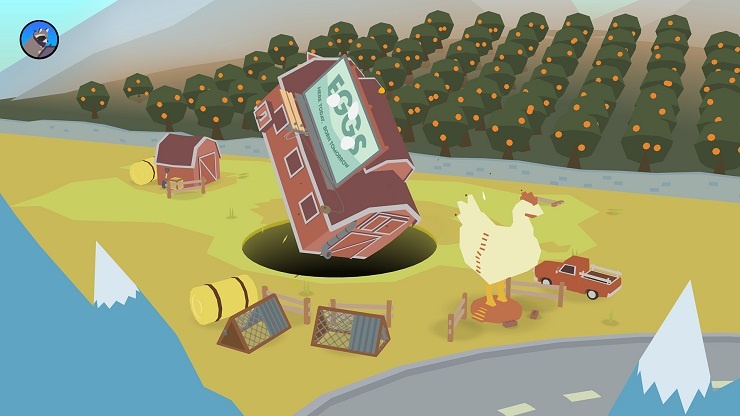Donut County has you guiding a mobile hole that swallows things up, but there is much more to it than that.
Dropping things down a hole seems like a funny premise, but how long could that stay fun for? Even if you throw in some funny raccoons, tossing stuff in a pit can only be fun for so long. Donut County offers some more interesting ideas with hole growth, combinations, and some other delightful elements that will make you want to keep tossing stuff in there.
Indie Games Plus spoke with Ben Esposito, developer of Donut County, to learn more about how they broadened the idea of having a hole swallow things up into a more compelling play style, how they created challenges around various unique gimmicks, and how exploring the story of the place you’re destroying added onto the game’s appeal.

Indie Games Plus: What inspired the all-swallowing hole mechanic of Donut County?
Ben Esposito: It all started as a joke. There’s a twitter account called Peter Molydeux, a parody of acclaimed designer Peter Molyneux. He made a joke about a game where you play as a hole. I thought it was a funny (and potentially fun? maybe bad?) premise for a game, so I prototyped it. It turned out to be really engaging and kind of mysterious!
What thoughts went into turning a hole into a play mechanic?
When I started with a hole, it was actually pretty boring – you just swallowed stuff. There was no thought to it, and no challenge. I thought about what kind of decisions are involved in ‘being’ a hole, and since it’s so simple, I really only had a few options: your position, the timing, and the amount of stuff you have put into the hole. The growing from small to big mechanic followed pretty naturally from that. Plus, that trail was already blazed by Katamari Damacy, so I knew I was in good company [laughs].

How do you design a given area around the hole mechanic? How do you create a challenging puzzle out of making things fall into a growing, movable pit?
It’s actually pretty challenging, because I put so many constraints on the gameplay. I wanted to make a really accessible game to kids and adults – gamers and non-gamers alike. That meant there would be no fail states in the game – you can’t die. Free movement, no grids. Few timing challenges. Also, there’s only ever one button (and I ended up barely using it!).
With so many constraints, it made sense to build the puzzles contextually – each level would have a gimmick that modifies the hole in some way. The gimmick would either give you a new affordance (a snake lets you whack stuff above the ground), or modifies what you can do (a hole full of water means you can’t collect anything).
Can you walk us through an example of creating one such area, and how you built it up around the mechanic?
The Beach Fireworks level happens around half-way through the game. I already had a concept of elemental states for the hole: swallowing fire sets your hole on fire. If you place something flammable in the hole when it’s on fire, it usually pops back out in a different form.
In the fireworks level, I wanted to do a more temporal puzzle…you can’t set your hole on fire permanently. So the gimmick was that a firework could be lit or unlit. If you collected an unlit one, nothing would happen. If you collected a lit one, it would shoot straight up out of the hole, allowing you to aim it.
It’s not a complex puzzle, but I think having timed states, plus the funny theme, makes it work.

The hole is good for more than just devouring things. What drew you to add elements like mixing and expelling? What do you feel they added to the experience?
I thought it was really interesting to explore what happens to stuff when it gets swallowed by the hole, off-screen and out of sight. It allowed me to play with expectations, like when you put multiple bunnies in the hole, they mate and produce many more.
Combinations and launching stuff out of the hole both expands the complexity of the game, but they also add a certain character to the logic of the hole. You know, subconsciously, that there’s a designer who has a certain set of rules for how objects might combine down there. Puzzle games can be as much a dialogue between the player and the system as between the player and the designer. I find the latter really interesting!
What drew you to tie the story of raccoons and garbage around the mechanic. How do you feel that this particular narrative frame enhances playing with the hole mechanic? What does the story do to make it that much more fun?
When you make a game about a hole, the game isn’t really about the hole…it’s more about what you put inside the hole. Since it’s naturally a game about destroying and erasing a place, I thought it would be interesting to explore the place, who lives there, and what their displacement means to them. I don’t think I needed to answer the question of why are you playing as a hole, but I don’t really see a point in making art if you don’t bother to ask why… even if it’s just for yourself.
Donut County is available for $12.99 on Steam and the PlayStation Store, or $4.99 on the App Store.

